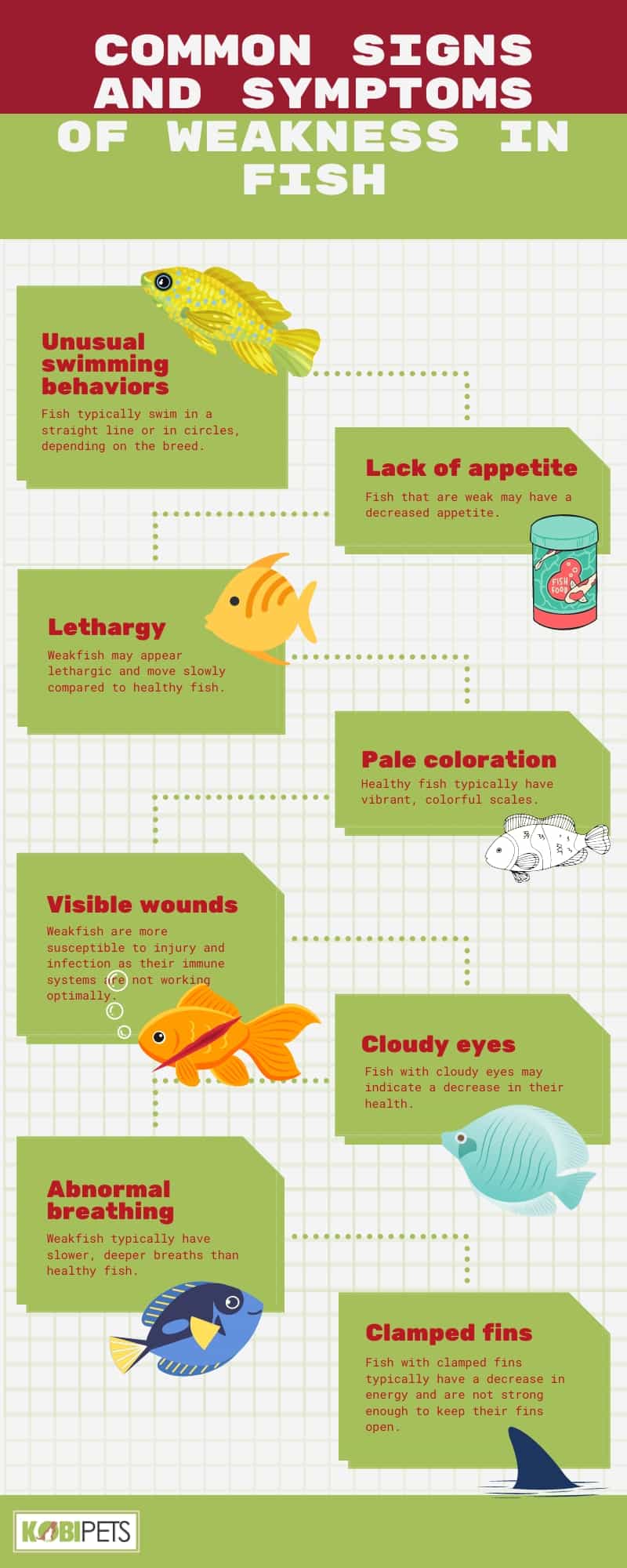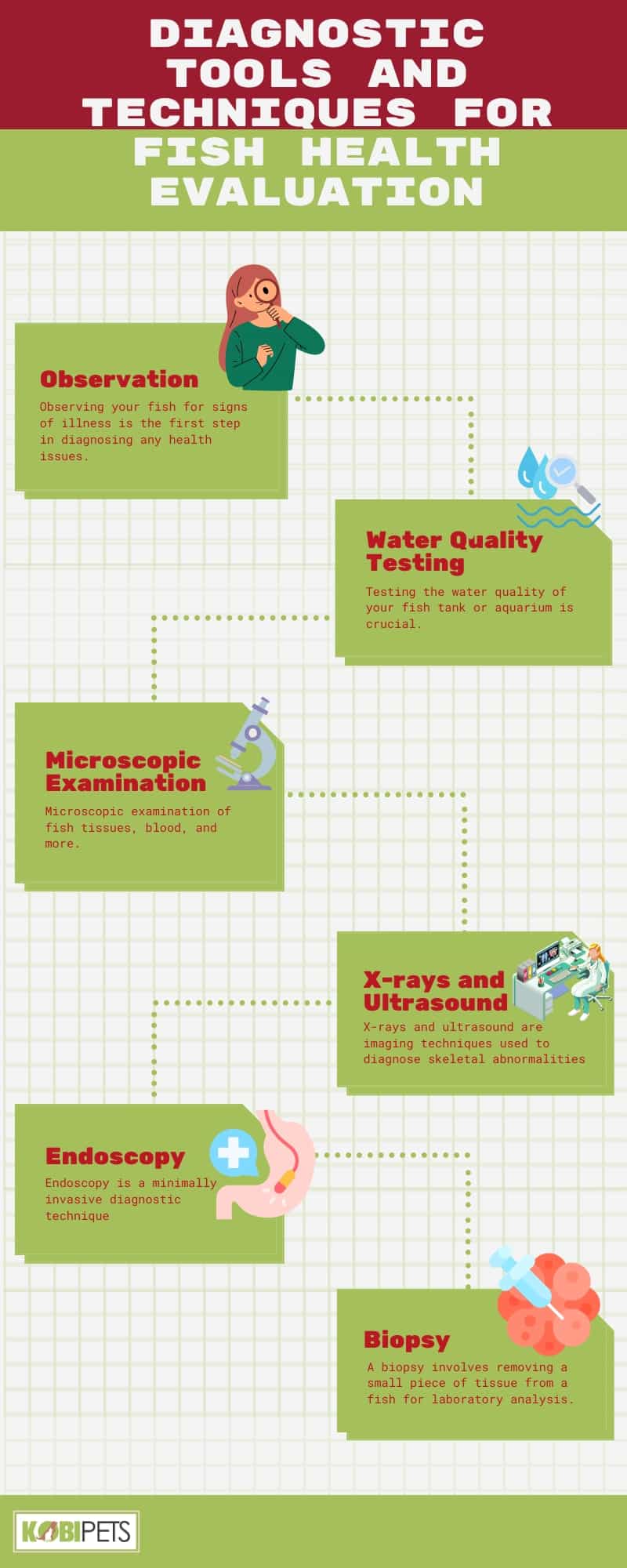
Many pet owners take great joy in caring for their fish but are sometimes left feeling helpless when problems arise. Identifying and correcting the underlying causes of poor health and illness in fish can be difficult—particularly as these creatures have had no voice to express their pain and discomfort.
By using a combination of observation, water quality testing, microscopic examination, imaging techniques, and biopsy, fish owners can maintain the health and well-being of their pets and ensure a long and happy life for their fish.
By providing easy-to-follow instructions on identifying issues such as ill health, weight loss, or behavioral changes, this guide will allow you to confidently give your fish the care it deserves.
Common Signs and Symptoms of Weakness in Fish
Fish can be affected by a variety of conditions and diseases, many of which can cause weakness in the fish.
Common signs and symptoms of weakness in fish include lethargy, lack of appetite, pale gills, erratic swimming movements, and an overall decrease in activity.

Common Signs and Symptoms of Weakness in Fish
- Unusual swimming behaviors: Fish typically swim in a straight line or in circles, depending on the breed. Weakfish may have an unusual pattern of swimming, such as zigzagging or erratic behavior. This could be caused by stress, poor water conditions, or a lack of oxygen.
- Lack of appetite: Fish that are weak may have a decreased appetite. This could be due to illness, stress, or other environmental factors.
- Lethargy: Weakfish may appear lethargic and move slowly compared to healthy fish. They may also be less active than usual and not react to stimuli as quickly.
- Pale coloration: Healthy fish typically have vibrant, colorful scales. Weakfish may be paler than usual due to a decrease in oxygen or poor nutrition.
- Visible wounds: Weakfish are more susceptible to injury and infection as their immune systems are not working optimally. Wounds, such as ulcers or sores, may be visible on the fish’s body.
- Cloudy eyes: Fish with cloudy eyes may indicate a decrease in their health. This could be due to poor water quality or an infection.
- Abnormal breathing: Weakfish typically have slower, deeper breaths than healthy fish. They may also have difficulty staying afloat and may even sink to the bottom of the tank.
- Clamped fins: Fish with clamped fins typically have a decrease in energy and are not strong enough to keep their fins open. This can be caused by stress, poor nutrition, or infection.
Identifying the Underlying Causes of Weakness in Fish
Identifying the underlying causes of weakness in fish is important for ensuring their health and well-being.
Many factors can cause fish to become weak, including stress, poor nutrition, poor water quality, illnesses or infections, and environmental changes.
By understanding these potential causes and observing your fish closely, you can better identify the source of the problem and take steps to address it. With the right care and attention, you can ensure that your weak fish has a chance of making a full recovery.
- Insufficient or poor diet: One of the leading causes of fish weakness is a lack of nutrition. An improper diet can include food that is not designed for consumption by aquarium fish, overfeeding, underfeeding, or simply providing insufficient variety.
- Parasites and Pathogens: Several parasites and pathogens can weaken a fish’s immune system and cause stress to their bodies, which makes them more susceptible to disease and death. Common parasitic organisms associated with fish include protozoans (e.g., flagellates, ciliates), nematodes (roundworms), crustaceans (copepods, amphipods), and trematodes (flukes).
- Water Quality Issues: Polluted water can also lead to weakened fish due to toxins that can be released into the tank from household cleaners, medications, or even food waste. Changes in pH levels, ammonia concentrations, and other water parameters can also significantly reduce a fish’s health.
- Physical Injury: Fish are very delicate creatures and any physical injury such as tail rot or fin rot can result in increased susceptibility to diseases and poor vitality. Additionally, rough handling during transport or netting can lead to the weakening of a fish’s body condition.

Diagnostic Tools and Techniques for Fish Health Evaluation
Diagnostic tools and techniques are essential in evaluating the health of your pet fish. These tools and techniques can help identify underlying health problems, allowing you to take appropriate preventive measures and treatments.
Here are some commonly used diagnostic tools and techniques for fish health evaluation:

Diagnostic Tools and Techniques for Fish Health Evaluation
- Observation: Observing your fish for signs of illness is the first step in diagnosing any health issues. You should look out for symptoms such as lethargy, loss of appetite, abnormal swimming patterns, unusual markings or discolorations, and gasping for air at the water’s surface.
- Water Quality Testing: Testing the water quality of your fish tank or aquarium is crucial in maintaining the health of your fish. You can use test kits to measure the levels of ammonia, nitrites, nitrates, pH, and other chemical parameters in the water. Poor water quality can cause stress and weaken your fish’s immune system, making them more susceptible to illnesses.
- Microscopic Examination: Microscopic examination of fish tissues, blood, or fecal samples can help identify bacterial, viral, or parasitic infections that may be affecting your fish. This technique is usually performed by a trained veterinarian or aquatic biologist.
- X-rays and Ultrasound: X-rays and ultrasound are imaging techniques used to diagnose skeletal abnormalities, tumors, and other internal organ problems in fish.
- Endoscopy: Endoscopy is a minimally invasive diagnostic technique that involves inserting a flexible tube with a camera into the fish’s digestive tract to visualize any abnormalities.
- Biopsy: A biopsy involves removing a small piece of tissue from a fish for laboratory analysis. This technique is used to diagnose skin, muscle, or organ diseases and to determine the appropriate treatment.
Preventive Measures and Treatment Options for Weakness in Fish
Weakness in fish can be caused by a variety of factors, including poor water quality, parasites, and bacterial infections. Fortunately, there are preventive measures and treatment options available to help keep your fish healthy.
Preventive measures are the best way to avoid any health issues with your fish. It is important to maintain good water quality by regularly testing for pH levels and other contaminants.
Additionally, it is important to quarantine any fish that show signs of disease or illness and isolate them from other fish in the tank. This will help prevent the spread of disease throughout the tank.
If your fish does become weak or ill, there are several treatment options available. Antibiotics such as penicillin, amoxicillin, or erythromycin can be used to treat bacterial diseases.
For parasites such as “Ich”, chemical baths like formalin can be used to remove them from the tank. Additionally, adding antibiotics to the water and using antibiotic-medicated food can help treat sick aquarium fish.

When to Seek Professional Help for Your Pet Fish
When it comes to the health of your pet fish, it is important to know when you should seek professional help. If your fish show signs of weakness or illness such as erratic swimming, loss of appetite, pale gills, lethargy, visible wounds, cloudy eyes, and clamped fins for more than three days then you should consider seeking professional help.
It is important to seek out a veterinarian or qualified fish specialist with experience in diagnosing and treating aquatic species. This individual can provide more advanced treatment options, such as administering medications that are not available over the counter.
Additionally, they can provide advice on how to keep your tank in optimal condition and support you through any health issues your fish may be facing.
Taking the time to recognize the signs of illness and seeking professional help can help ensure that your pet fish receive the best care possible.
With a proper diagnosis and timely treatment from a qualified individual, you can rest assured that your fish will have an increased chance of making a full recovery.

In conclusion
A healthy pet fish is integral for a peaceful atmosphere in your home.
If you want to prevent major issues such as prolonged suffering, as well as necessary clinical costs, it’s important to get an early start on correctly diagnosing any weakness in your fish before it becomes serious.
By taking proper steps such as observing the fish environment, nutrition, and other habits, observing changes in behavior over time, and regularly contacting knowledgeable professionals when needed, you can save yourself both distress and money.


